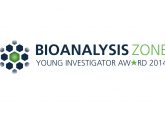2015 Young Investigator: Pierre-Yves Caron

Nominee:
Nominated By:
Supporting Comments:
What made you choose a career in bioanalysis?
As an undergraduate student, I was fortunate to work as an intern at several large pharmaceutical companies and familiarize myself with many fields of the drug development process. These experiences stimulated my interest and led me to complete my M.Sc. degree in synthetic organic chemistry. Being familiar with the synthesis of active pharmaceutical ingredients, I was drawn to bioanalysis as this discipline represents a crossroad of many scientific domains filled with new challenges. My work as a research scientist in the bioanalytical industry is to develop methods for quantitation of drugs in biological matrices using mainly liquid chromatography and mass spectrometry (LC-MS/MS).
Describe the main highlights of your bioanalytical research, and its importance to the bioanalytical community.
One of the critical parameters to be aware of when developing a bioanalytical method is matrix effects. In LC-MS/MS, this parameter can be defined as signal suppression or enhancement, induced by the matrix endogenous co-extracts in the sample. Regulatory guidelines require the evaluations of such matrix effect during method validation. Generally, the industry evaluates the matrix effects by comparing analyte and internal standard ionization variations using a reference standard solution in the presence, or not, of blank matrix co-extracts from different sources. This way of assessing matrix effects will give a good idea on how the ionization suppression or enhancement will differ from a matrix to another.
However, using spiked samples, it was proven that for some molecules, the widely used ionization suppression test (commonly known as matrix factor) could meet acceptance criteria, but still matrix co-extract had an impact on quantitation and accuracy. Based on the results obtained from a combination of both tests, it is possible to pinpoint a specific cause related to either ionization or sample extraction. This allows one to focus on the right issues during method development. The work performed has been presented several times in different scientific conventions and this topic generated many discussions.
Describe the most difficult challenge you have encountered in the laboratory and how you overcame it.
Always reaching for lower limits of quantitation is a daily challenge faced by bioanalytical research scientists today. The concentration of drugs administered to patients constantly gets lower, which is beneficial to patients, reducing the risks of side effects, however the requirements for more sensitive analytical methods also must evolve. From a scientific point of view, increasing sensitivity in order to reach ultra-low limits of quantitaton requires carefully optimized sample extraction, chromatography and instrument detection.
I came across this type of challenge when an assay was developed and validated for Mometasone Furoate that required detection as low as 250 fg/mL, eight times lower than the previously obtained lower limit of quantitation from an earlier method. Sample extraction was optimized to remove matrix co-extracts, which would cause ion suppression, by combining a liquid-liquid extraction followed by a solid phase extraction. Transfer to UPLC chromatography and fine-tuning of instrument detection were also the key to obtain maximum analyte and internal standard area responses. Method development resulted in a successful method validation and clinical sample analysis. The method was used for several bioanalytical studies and the mean incurred samples reanalysis confirmation rate was of over 96%, which illustrates the robustness of the assay.
Where do you see your career in bioanalysis taking you?
I am fortunate to be part of a leading global Contract Research Organization (CRO) and to work with a team of skillful bioanalytical research scientists and project coordinators. The ability to work in a motivating environment with diligent people all makes the experience even more gratifying.
In the upcoming years, I want to continue to improve my laboratory experience by experimenting with new extraction procedures and detection methods. I want to increase my knowledge in analysis of large molecules and stay up-to-date with new technologies and how they can impact and improve my work. Also, I want to make sure I interact with and learn from other scientific disciplines, in order to to gain knowledge needed to face new and ever-challenging objectives.
How do you envisage the field of bioanalysis evolving in the future?
Development of more sensitive assays has always been important and it will be a constant daily challenge for bioanalytical scientists. Better assays mean lower matrix volumes can be used to obtain the same amount of information. Patient well-being is important and this is a way to achieve it. Quantitation of large molecules (peptides, proteins) is also a topic of choice for the upcoming years. Exploring new ways to identify, extract, detect and quantitate these entities will play a big role in the upcoming drug development process. As challenges continue to grow, it will be important to maximize the benefits of multidisciplinary teamwork in our field. Bioanalysis is a prime example of a scientific field in which different scientists coming from a range of academic backgrounds can cooperate in order to solve today’s problems in terms of drug development. Demand for analysis of more complex and large molecules continues to grow and this expertise requires different scientific fields to work as a unit in order to achieve these goals.
Please list up to five of your publications in the field of bioanalysis:
1. Bilodeau J, Lafontaine N, Caron P-Y et al. Evaluation of Matrix Effect when Matrix Factor is not Enough for LC-MS/MS Bioanalytical Method. European Bioanalysis Forum 6th Open Symposium. Barcelona, Spain, 20—22 November 2013.
2. Caron P-Y, Jean N, Théberge M-C, Boudreau N, Levesque A. Use of Sodium Adduct Combined with Improved Sample Extraction for Femtogram Level Detection of Mometasone Furoate by UPLC-MSMS. AAPS Annual Meeting and Exposition. San Antonio, TX, USA, 10—14 November 2013.
3. Ravindar K, Caron P-Y, Deslongchamps P. Anionic Polycyclisation Entry to Tricycles Related to Quassinoids and Terpenoids: A Stereocontrolled Total Synthesis of (+)-Cassaine, J. Org. Chem. 79 (17), 7979—7999 (2014).
4. Ravindar K, Caron P-Y, Deslongchamps P. Total Synthesis of (+)-Cassaine Utilizing an Anionic Polycyclisation Strategy. Org. Lett. 15 (24), 6270—6273 (2013).
5. Caron P-Y, Deslongchamps P. Versatile Strategy to Access Tricycles Related to Quassinoids and Triterpenes, Org. Lett. 12 (3), 508—511 (2010).
Please select one publication from above that best highlights your career to date in the field of bioanalysis and provide an explanation for your choice.
First choice: Bilodeau J, Lafontaine N, Caron P-Y et al. Evaluation of Matrix Effect when Matrix Factor is not Enough for LC-MS/MS Bioanalytical Method. European Bioanalysis Forum 6th Open Symposium. Barcelona, Spain, 20—22 November 2013.
Reasoning: This presentation contains the results obtained from a study of matrix effects. It details both tests and compares their results to figure out how both tests are complementary and not self-excluding. The presentation has been presented at EBF 2013, WRIB 2014 and ASMS 2014.




